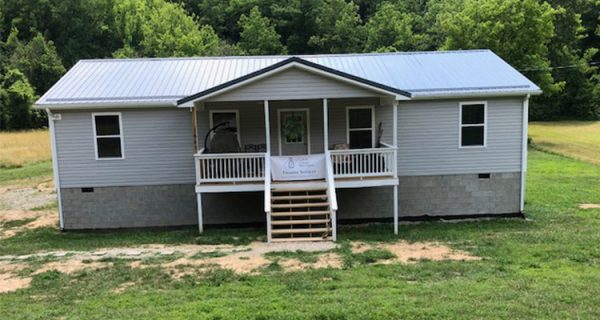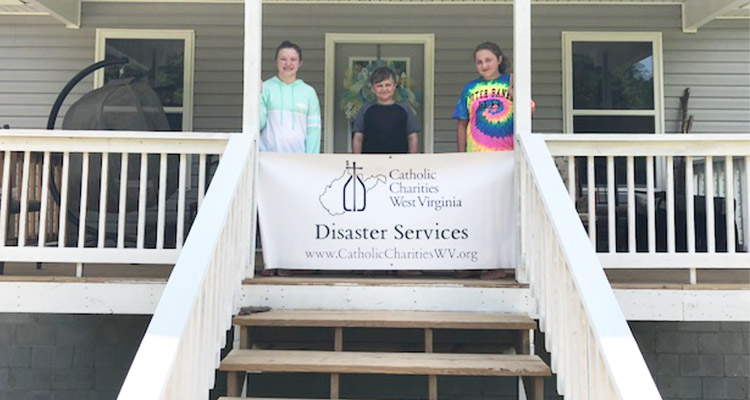Over the past two years, West Virginians have come together to rebuild in the aftermath of the deadly, historic flooding of June 2016. That flooding touched 42 of West Virginia’s 55 counties and caused devastation across a 12-county area.
“On this second anniversary of the devastating floods of 2016, we continue our commitment to be compassionate and responsive in providing ongoing disaster services and helping families on the road to recovery,” said Paula Taylor, Catholic Charities West Virginia (CCWVa) Board of Directors president. “We are so incredibly grateful to West Virginians who have committed their time and resources to helping their neighbors recover.”
 CCWVa’s Disaster Services program has provided nearly $700,000 to 318 households for disaster recovery over the last two years.
CCWVa’s Disaster Services program has provided nearly $700,000 to 318 households for disaster recovery over the last two years.
With an anticipated three- to five-year recovery period, much progress has been made. However, CCWVa officials say they know from experience that long-term recovery takes time, and they are committed to helping flood survivors on their path to recovery for as long as it takes.
“We are much closer to returning all families to recovery than when we started, but there are still families in need of our support,” said Lora Pierce, CCWVa Director of Disaster Services. Pierce said CCWVa has used funds from generous donors to help flood survivors with new foundations, gutters, driveways, bridges, appliances, windows, roofs and more.
“We’ve helped with pretty much every aspect of recovery that there is,” said Pierce. “And it is through partnerships with other wonderful organizations that we have been able to contribute to the recovery of so many.”
CCWVa Disaster Services program provides long-term recovery support through disaster case management, support to Long-Term Recovery Committees, and through funding.
Joe Ross, chair of the Roane County Long Term Recovery Group, expressed his gratitude for CCWVa’s support.
“It is so hard to put in words how thankful we are to Catholic Charities. Catholic Charities has been with our Long Term Recovery Group from the very beginning and has literally been the foundation of our group,” said Ross. “Among so many other things, Catholic Charities has paid for every foundation for every home we have built. So many have given so much from their hearts, and we value every dollar and are dedicated to being good stewards of all that has been given.”
One of the families who received this support was the Helmick family. Nick and Jessica Helmick and their three children were living in a 30-foot by 12-foot enclosure after their home was destroyed by the June 2016 flood. The damages their home sustained were beyond what they could fix themselves.

“They needed help,” said Ross. “The Roane LTRC was ready and got the family started on the path to recovery. With the help of Catholic Charities and other organizations, we were able to move them into a tiny home while their new home was constructed.”
The Helmick family moved into their new home last August, and they were able to enjoy their first Thanksgiving in their new, safe home.
“Our goal is to return families to homes that are safe, sanitary and secure,” said Pierce.
To reach this goal, CCWVa ensures mitigation is part of the recovery process. Pierce said disaster case managers help ensure recovery efforts are sustainable. This means everything from helping people move out of floodplains to ensuring elevation of HVAC units to installing drainage systems to prevent future flooding.
HVAC damage or loss is one of the most common losses in flooded households. In Clay County, in particular, disaster case management reports indicated a high number of households in need. With an estimated cost of $5,000 to install a new HVAC, the total amount needed was staggering.
Through funding from major grants, CCWVa was able to facilitate the purchase and installation of 25 new HVACs for flood survivors in Clay County. This funding impacted the lives of nearly 100 individuals by providing a basic necessity (heat and air) for their homes and filling a vital piece in their full disaster recovery.
CCWVa also recognizes that preparedness is a crucial part of dealing with a disaster. In the aftermath of a disaster, churches often find themselves at the center of the response and recovery effort. In recent months, the CCWVa Parish Social Ministry office has begun facilitating the development of disaster committees in parishes throughout the state to help them begin developing a plan for how they can serve when disasters strike.
Kate Kosydar, CCWVa Parish Social Ministry coordinator, explained that preparation is key to mitigating loss and harm in the event of a disaster. “CCWVa connects resources to needs. Having points of contact in communities around the state enables our agency to better serve our neighbors if — that is, when — a disaster strikes,” said Kosydar.
Although much progress has been made in the past two years, the road to recovery from the June 2016 flood continues.
“CCWVa will be walking this road with families and communities for as long as it takes to help people rebuild their homes and lives,” said Pierce.
For more information about CCWVa Disaster Services, visit www.CatholicCharitiesWV.org/disaster-recovery-services.

Weelunk is proud to have the Diocese of Wheeling-Charleston
as a generous supporter.



